Ask Ethan: Did Some Of Earth’s Meteorites Originate Beyond The Solar System?
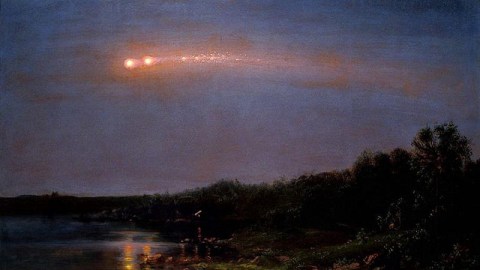
It’s not a question of could they, but have they? Here’s how we’ll find out.
It’s no secret that fragments of asteroids, comets, and other spaceborne objects have been found here on Earth. Whenever a naturally occurring object encounters planet Earth, it speeds through our atmosphere, creating a spectacular streak of light: a proverbial shooting star. Most of these are assumed to originate in our own Solar System, consistent with our experience with meteor showers, and some of them even make it to Earth’s surface, becoming meteorites. But, with the recent visit from an interstellar interloper — ‘Oumuamua — are we certain that they’re all from close to home? That’s the question of Jan Rolstad, who asks:
The passage of ‘Oumuamua through our planetary plane got me wondering about something. Most meteorites found on Earth are dated back as far as 4.6 billion years, or the age of our solar system. What if a meteorite was found that had originated in a another, much older planetary system. How would an eight billion year old piece of an alien system be recognized, or would it? Maybe some of the space rocks being found on Earth are like ‘Oumuamua, visitors from another star.
It’s absolutely possible. Here’s how we’ll find out.

Thus far, all across the world, we have enormous evidence for Earth having a rich history of collisions from objects from outer space. While you might typically think of “the big one,” like the asteroid strike that wiped out the (non-avian) dinosaurs some 65 million years ago, most of the collisions that Earth experiences are from smaller, less massive, and less energetic objects.
Sure, the overwhelming majority of what strikes planet Earth from space is too small to make it down to the surface, but we still receive meteorites intermittently. While enormous craters like Barringer crater (above) often have meteorite fragments near their centers, at the impact site, there are smaller strikes that occur far more frequently. Even though most of them are so small that they burn up in Earth’s atmosphere, plenty of these space rocks eventually make it to Earth.

You might be familiar with the larger, damage-inducing events like the Tunguska event of 1908 or the Chelyabinsk strike more recently, in 2013, but these are again a minority. They may not be the 1-in-100,000,000 year events like the Chixulub crater event, or even the 1-in-10,000 year events that led to Barringer crater, but even these once-per-century events aren’t most of what make it to the ground.
Instead, there are strikes that occur more frequently than once-per-year, where fragments of bolides — bright meteors that leave long, luminous trails in our atmosphere — make it to Earth’s surface. Most of these break up in the atmosphere, while most of the ones that reach the surface strike the ocean. Still, a significant fraction fall on land, and some of them, like 1969’s Murchison meteorite, can be seen falling and then have their surviving fragments recovered. In one case, a meteorite even struck a human during its final fall to Earth, the only such case known.

When these objects do make it to our surface, they go from meteors to meteorites, meaning that they leave fragments behind that can be collected and analyzed. While there are over 1,000 documented meteorite falls, there are closer to 60,000 meteorites that have been found on Earth: the majority of them are not witnessed by humans. This is because even though the odds that a meteor strikes Earth is largely location-independent, human population is clustered together in cities and other regions well-suited for human habitability.
However, not seeing a meteor fall doesn’t preclude us for determining their composition, and that composition provides a clue as to their origin. In previous generations, meteorites were categorized very coarsely: you were either
- a stony meteorite, made mostly of silicate rock,
- an iron meteorite, made mostly of iron, nickel, and similar metals,
- or a stony-iron meteorite, with large amounts of both silicate-based and metal-based materials.
If all of the meteorites we found had a common origin, like the asteroid belt, this classification would have been all we ever needed.
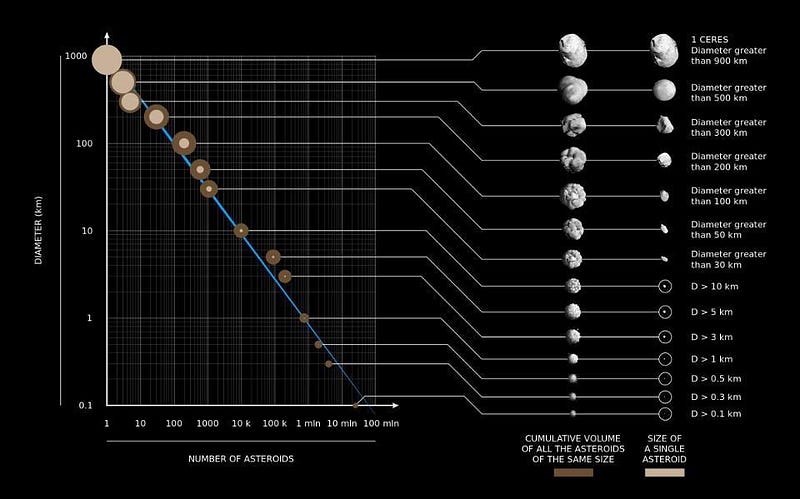
In more recent times, we now categorize them according to their physical structure, their mineralogy, and the composition of the chemicals, elements, and isotopes that compose them. Prior to 1900, only perhaps a few hundred meteorites were known, and they were largely of the iron or stony-iron varieties, since they’re the ones most easily distinguishable from terrestrial rocks.
However, we developed a much greater understanding of meteorites in the 20th century, and both scientists and amateur citizen enthusiasts began searching for them all over Earth’s surface. With a much larger sample of meteorites, we discovered that a whopping 94% of all of them are actually stony (silicate-based) meteorites, and so it became necessary to develop a better classification scheme. Otherwise, you’d lump all of the most common class of meteorite together, and there are enormously important differences between them.
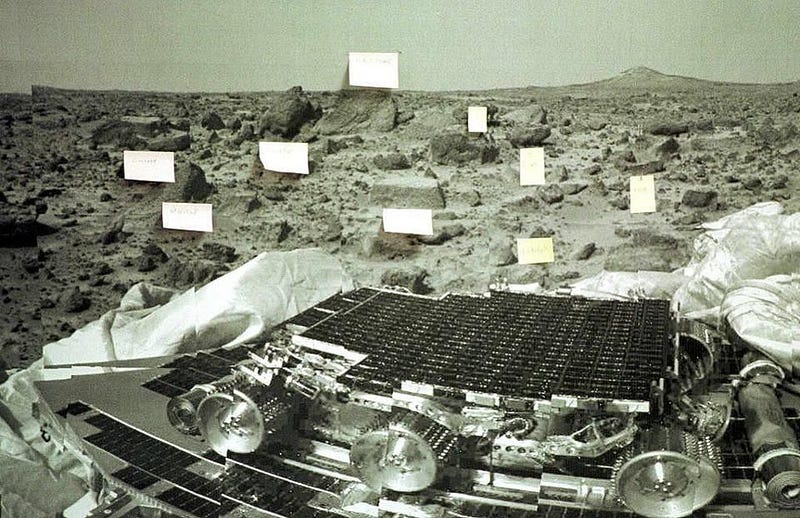
Here’s the biggest one, and one of the most surprising discovery about meteorites in our lifetimes: about 3% of all the meteorites found on Earth originate from Mars.
This was suspected for many years, but the proof came in 1997: when the Mars Pathfinder mission successfully landed on and roved across the Martian surface. The physical and chemical composition of rocks there matched a fraction of the meteorites found on Earth, and suddenly revealed that their origin was not from the asteroid belt, but from Mars.
How a meteorite’s origin is determined is closely related to how it’s age is determined. To get there, you have to take a look inside.
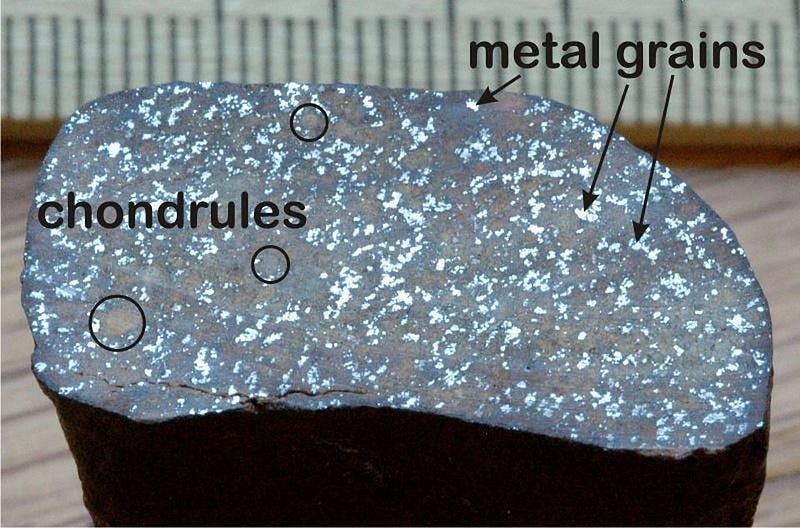
Remember: 94% of all meteorites are stony meteorites. If you have one and cut it open, you’ll find that there are two classes of stony meteorite:
- chondrites, which have small, round particles (known as chondrules) inside of them,
- and achondrites (which includes all of the meteorites from Mars), which don’t.
About 86% of all meteorites are chondrites, and contain these silicate minerals that show evidence of having been melted a long time ago. While some chondrites contain organic matter like amino acids, they all contain a wide variety of elements inside of them. The asteroid belt is theorized to be primordial material left over from the formation of our Solar System, some 4.56 billion years ago. The way we determine the age of the Solar System comes, in part, from looking at these chondritic meteorites, and in particular at the elements and isotopes found inside. The key to understanding their ages is to look at the reactants and products of radioactive decay.
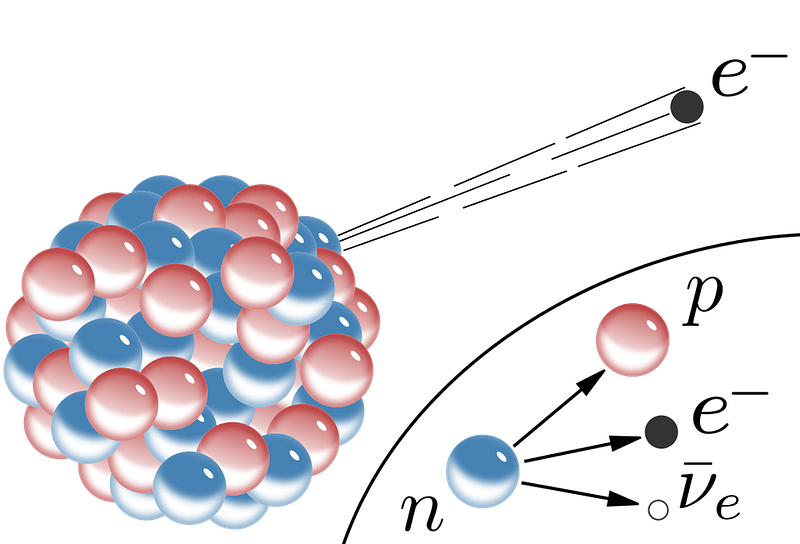
For example, both the elements Rubidium (Rb) and Strontium (Sr) are found in nature, with a variety of different isotopes. Rubidium, for example, only has one stable isotope (Rb-85), but it has a second very long-lived isotope (Rb-87), which has a longer half-life than the age of the Universe: at 49 billion years. Strontium, on the other hand, has four stable isotopes: Sr-84, Sr-86, Sr-87 and Sr-88, with no long-lived unstable isotopes.
An object will begin its life with a certain amount of all six of these isotopes, but we should focus on three in particular: Rb-87, Sr-87, and Sr-86. Think about it as follows:
- When our Solar System first forms, there’s an original amount for all three of these: Rb-87, Sr-87, and Sr-86.
- As time goes on, some of the Rb-87 will decay into Sr-87, so that the amount of both Rb-87 and Sr-87 changes over time.
- However, the amount of Sr-86 doesn’t change over time; nothing decays into it and it doesn’t decay into anything.
- Therefore, if you measure two ratios at the oldest points within a sample — the Rb-87/Sr-86 ratio and the Sr-87/Sr-86 ratio — you can derive how much time has passed since this sample was created.
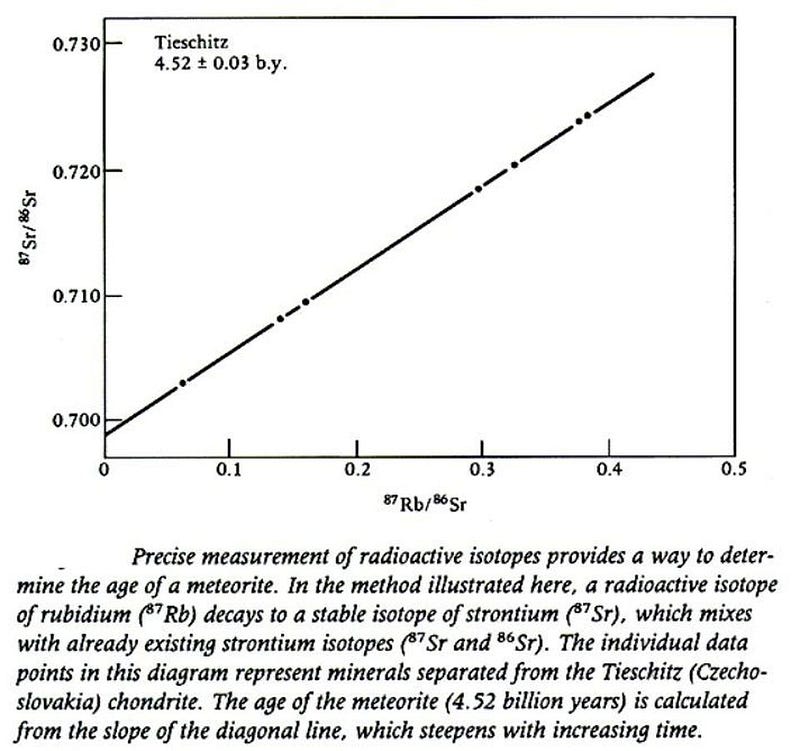
This method is absolutely brilliant for one compelling reason: it requires no assumptions about the composition of the initial material. The only variable is time, or how long it’s been since this sample was created.
This is how we infer the age of the various meteorites we find on Earth. Rubidium and Strontium aren’t the only isotopes we use, of course; they’re simply examples. In addition, Uranium and Thorium (which decay into various isotopes of lead), Potassium (which decays into Argon), and Iodine (which decays into Xenon) are also used.
All told, the chondrites are approximately 4.5-to-4.55 years old, while the achondrites display enormous variations. This is largely because the achondrites are suspected to belong to large parent bodies, and are produced when they themselves are impacted, kicking up debris. In fact, within the achondrites, there are two special groups: one that corresponds to meteorites with lunar origins (as confirmed by the sample returns from the Apollo program) and one that corresponds to meteorites with Martian origins (as confirmed by various Mars rovers).
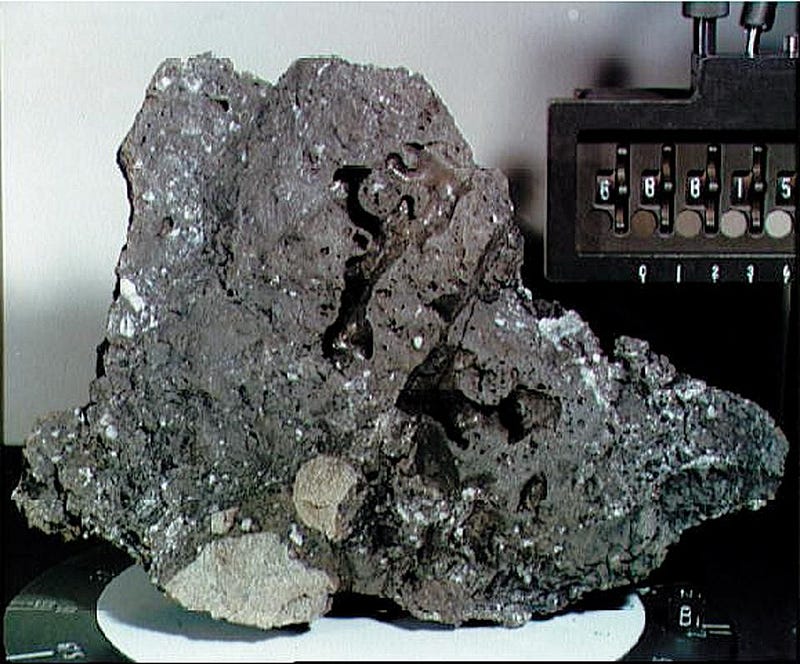
In general, the chondrite meteorites are likely all of asteroidal origin, and are all roughly the same age as the Solar System. The achondrite meteorites can be much younger: some of lunar meteorites are only 2.9 billion years old and some of the Martian meteorites are only 200 million years old. As long as radioactive dating doesn’t lie, we’d be able to identify whether a meteorite was of pre-solar origin simply by finding one whose isotopes told us it had been around longer than 4.56 billion years or so.
On the other hand, most of the meteors never make it down to Earth, but instead burn up in our atmosphere. In a remarkable study, it appears that one of them may have impacted Earth and done exactly that back in 2014.
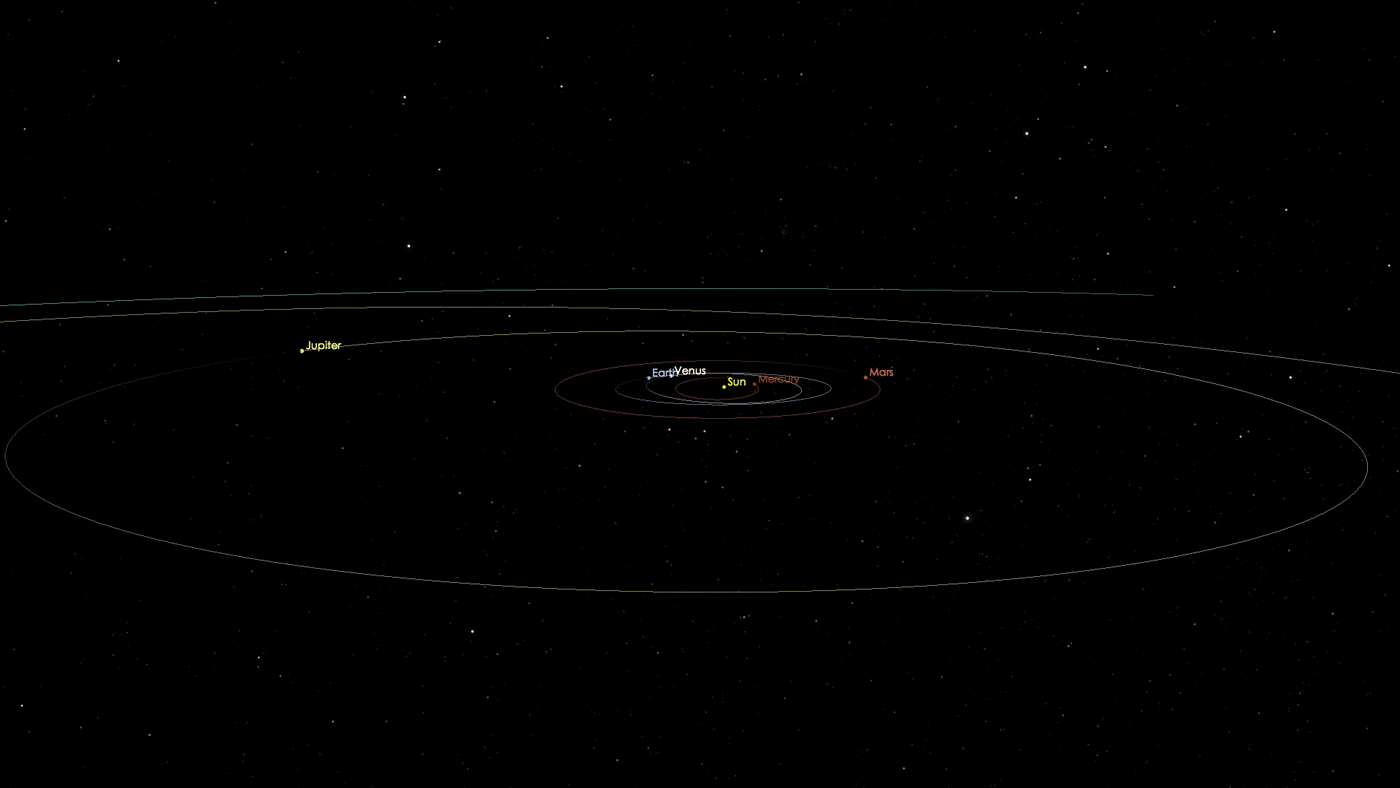
Just as the origin of ‘Oumuamua was identified based on its orbital parameters with respect to our Solar System, many other objects can have their orbital parameters either tracked or reconstructed. NASA’s Jet Propulsion Laboratory keeps a catalog of bolides that enables astronomers to reconstruct where an object might have come from and how quickly it may have been moving. A meteor from January 9, 2014, seen over Papua New Guinea, may have been our first identifiable interstellar bolide, according to a new (but not yet published) study.
In principle, we could identify an incoming object as having an interstellar origin by its velocity and trajectory, and then — when it strikes Earth — take its spectra, determining its composition. Even a meteor, not just a meteorite, could be identified as truly originating from beyond our Solar System.
With the possibility of interstellar origins for space rocks now a reality, it’s enough to make you want to do an atomic analysis of every meteorite ever identified on Earth, isn’t it?
Send in your Ask Ethan questions to startswithabang at gmail dot com!
Ethan Siegel is the author of Beyond the Galaxy and Treknology. You can pre-order his third book, currently in development: the Encyclopaedia Cosmologica.




